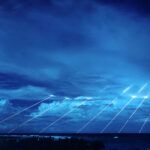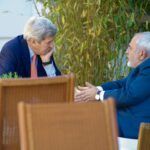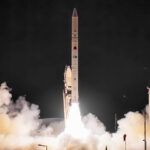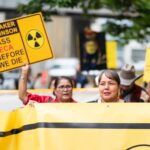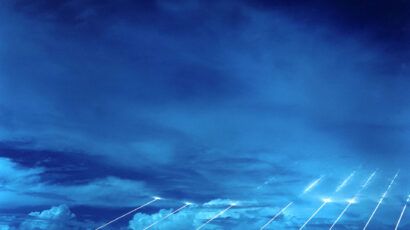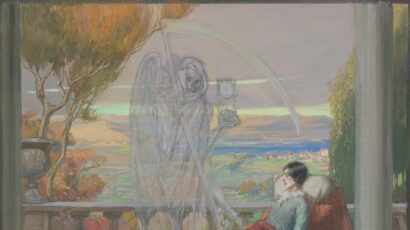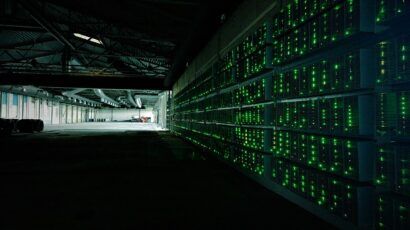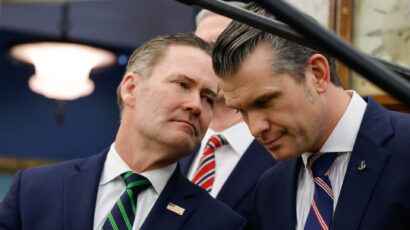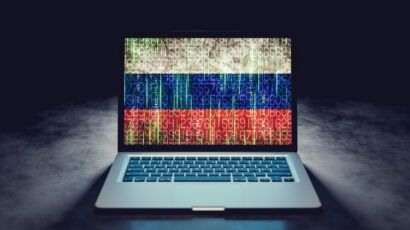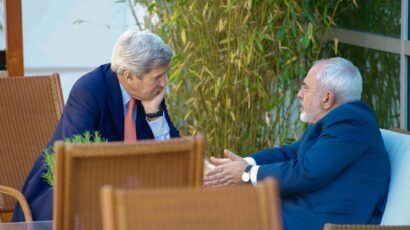How the fog of war in Ukraine increases the risk of escalation
By Stephen J. Cimbala, Lawrence J. Korb | October 24, 2024
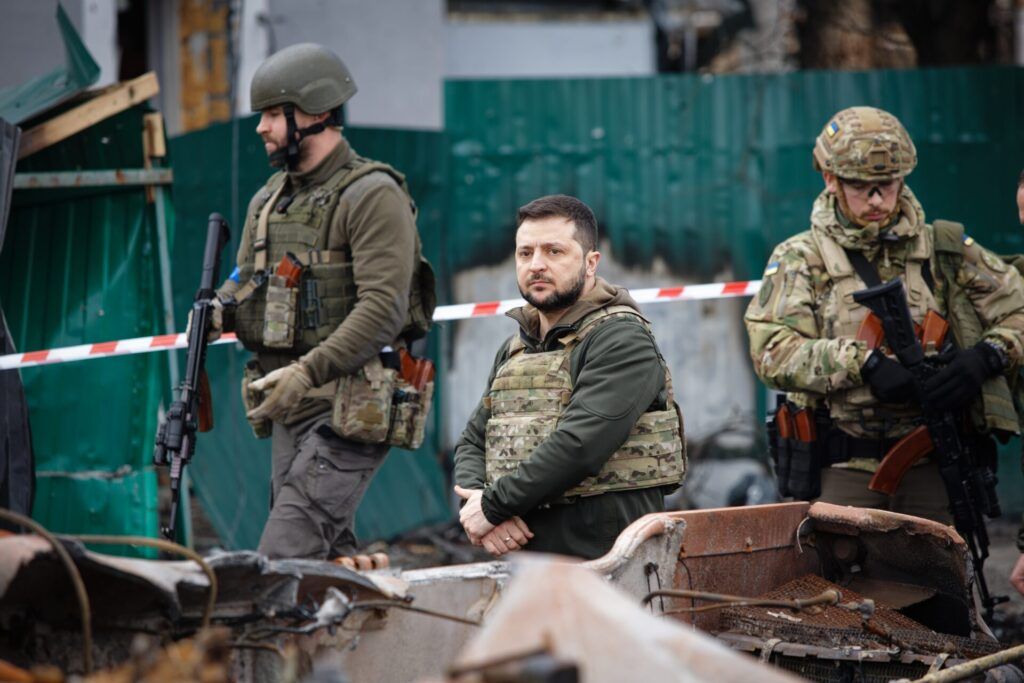 Ukraine President Volodymyr Zelensky visits the town of Bucha in Ukraine on April 4, 2022, after the retreat of Russian troops. (Credit: Photo by dmytro.larin.gmail.com / depositphotos.com)
Ukraine President Volodymyr Zelensky visits the town of Bucha in Ukraine on April 4, 2022, after the retreat of Russian troops. (Credit: Photo by dmytro.larin.gmail.com / depositphotos.com)
Discussions of escalation in the war between Ukraine and Russia have become more frequent in recent months. One such discussion occurred in September during Ukrainian President Volodymyr Zelensky’s latest visit to Washington, when some government officials and analysts emphasized the risk of nuclear war between NATO and Russia.
The possibility of nuclear war growing out of this conflict is a serious concern. But an all-out nuclear war is not necessarily the only, or most likely, means by which this war could expand and escalate up to nuclear use. The controversy surrounding Ukrainian demands for permission to use NATO long-range missiles for attacks deeper into Russia poses a major risk of escalation. Likewise, changes to Russia’s nuclear doctrine as the war continues—and its interpretation by Western allies—could make a nuclear first use more likely. Finally, non-nuclear forms of expansion of the war—whether they have already occurred or not—could pose significant challenges in moving toward de-escalation and an eventual peace agreement.
As the war drags on and pivots to a war of attrition, non-nuclear forms of expansion—be they horizontal, informational, technological, or moral—increase the likelihood of inadvertent use of nuclear weapons or other weapons of mass destruction.
Muddling with Western long-range missiles. In September, US Secretary of State Antony Blinken and UK Foreign Secretary David Lammy came to Kyiv to show support for Ukraine. When they arrived, the two officials were handed an open letter signed by 17 former British and American officials and other experts calling for urgent changes to the policy concerning US and UK missiles provided to Ukraine for use against Russia.
The specific issue was that the United States and the United Kingdom, which made available to Ukraine ATACMS (Army Tactical Missile System) and Storm Shadow long-range missiles, placed restrictions on the use of these missiles against targets deep into Russian territory and that these restrictions allegedly reduce the effectiveness of these missiles at a critical time in the war for Ukraine.[1]
These experts and diplomats are not alone in criticizing the United States and its NATO allies for mistakenly softening their level of commitment to support Ukraine in its war against Russia. According to Anastasia Edel, a Russian-born American writer and social historian, Putin has victory within reach because of insufficient US and allied commitment to a winning strategy. “By first casting its lot with Ukraine and then failing to follow through, America has lost its place as the bulwark of the West that can guarantee protection and peace to its allies,” Edel wrote.[2]
For his part, Russian President Vladimir Putin again warned in early September that allowing Ukraine to use long-range missiles provided by NATO to attack targets deeper into Russia would redefine the political character of the war. According to Putin, allowing Ukraine to fire Western weapons deep into Russia would mean nothing short of direct involvement:
“This will mean that NATO countries—the United States and European countries—are at war with Russia. And if this is the case, then, bearing in mind the change in the essence of the conflict, we will make appropriate decisions in response to the threats that will be posed to us.”[3]
Putin offered two reasons for his contention. First, NATO member states would have to provide Ukraine with the targeting data on Russia from NATO satellites. Second, NATO specialists would have to enter the targeting data into missile targeting systems because Ukrainians cannot do it themselves. On the other hand, since 2023, Ukraine has been using UK Storm Shadows and French-made Scalps against parts of Ukraine controlled by Russian forces and/or places Russia claims as its territory, such as Crimea.
Putin’s concern, therefore, might be that the capabilities of the most advanced versions of Storm Shadow and similar missiles would enable more devastating attacks against Russian air bases and command facilities as well as critical infrastructure deeper into Russia’s mainland. According to Simon Saradzhyan, the founding director of the Russian Matters Project at Harvard University:
“It is the damage that Storm Shadows and Scalps could cause to Russia’s military-political infrastructure, as well as to the Kremlin’s efforts to make sure the war stays in the background of most Russians’ lives so that they remain content with his rule, that may cross Putin’s red line, triggering his ‘appropriate’ response to NATO countries.”[4]
As Saradzhyan points out, a Russian response might take the form of an attack against transit facilities for these missiles in a NATO European country, such as an air base in Poland. Such an attack could activate NATO’s Article 5, effectively expanding the conflict to a war between Russia and NATO.[5]
Russia could also move military assets, including depots and air bases, even deeper into its territory as a passive instead of active response to longer-range missile attacks.
Changes to Russia’s nuclear doctrine. Putin’s comments are a reminder of the numerous threats from the Kremlin since the beginning of Russia’s attack on Ukraine, especially over the possibility of a nuclear first use. For example, in a September 1 interview, Russian Deputy Foreign Minister Sergei Ryabkov noted that Russia is in the process of revising its doctrine on the use of nuclear weapons and accused the West of fueling an “escalation” of the war in Ukraine.[6]
However, some US experts, including generals and diplomats, dismissed the possibility of Russian nuclear first use as lacking in credibility, arguing that:
“After more than 900 days of war, we can safely assert that Russian President Vladimir Putin’s repeated threats are nothing less than an attempt to deter Ukraine’s partners from properly arming her. Easing the restrictions on Western weapons will not cause Moscow to escalate. We know this because Ukraine is already striking territory Russia considers its own—including Crimea and Kursk—with these weapons and Moscow’s response remains unchanged.”[7]
To restore deterrence credibility, Russia might adjust its military doctrine concerning justifications for nuclear first use to include Ukrainian attacks on critical military and civil infrastructure targets with long-range conventional weapons.
Russia’s nuclear doctrine on “Basic Principles of State Policy of the Russian Federation on Nuclear Deterrence” was adopted in 2020. The document provided for two main scenarios under which Russia can use nuclear weapons: first, in response to an attack on the Russian Federation and/or its allies with nuclear or other weapons of mass destruction; or, second, in response to an attack with conventional weapons when the very survival of the Russian state is at risk.[8]
In a meeting with the Russian Federation Security Council standing conference on nuclear deterrence on September 25, Putin proposed several updates to Russia’s nuclear doctrine. First, he suggested that nuclear strategy should treat “aggression against Russia by any non-nuclear state, but with the participation and support of a nuclear state,” as a joint attack that could motivate Russia to cross the nuclear threshold. He then added that, after having received reliable information about any “massive” missile attack against Russia or its ally, Belarus, Russia would also consider resorting to a nuclear option.[9]
Russian academic and nuclear policy expert Alexei Arbatov has argued that prolonging the war in Ukraine has led to a widespread misconception about escalation, both in the West and in Russia.[10] The first mistaken assumption deals with the view of experts and officials in Western allies that there is no upper limit to NATO-supported Ukrainian attacks into Russian territory with conventional weapons without producing a nuclear response from Russia. In short, Russia has no red line. The second erroneous assumption, widely held among an “active political and expert lobby of fans of nuclear weapons” in Russia, Arbatov suggests, is that a very selective use of nuclear weapons by Russia will not be followed by a major war with NATO. The West will be sufficiently scared and back down.
But for Arbatov, what would follow even a limited Russian nuclear first use may be very different from what Russian leaders have in mind:
“NATO will openly enter the war and carry out at least a massive strike with conventional high-precision long-range weapons on both new and old territories of the Russian Federation. This will be followed by group nuclear strikes from the Russian side on NATO countries. In response, there will be a massive nuclear and conventional strike on Russia. We will not even be able to determine what is flying at us, and we will not have time to call the White House—contrary to the scenarios of Russian enthusiasts of a limited nuclear strike. It will be impossible to control the course of events.”[11]
Of course, much of this speculation is scenario-dependent.
Russian military expert and deterrence theorist Dmitri Adamsky analyzes Russian threats of nuclear escalation as part of a cross-domain “coercion cocktail” that accompanies conventional war-fighting without necessarily committing the Kremlin to any specific future action. According to Adamsky, a Russian slide from nuclear rhetoric into the reality of nuclear first use would not necessarily be abrupt. It might go through several phases of demonstrative “muscle flexing” and “strategic gestures” designed to signal preparedness for escalation, if necessary, but in gradual, and potentially reversible, steps—if favorable indications come from the other side. In this view, the West would need to take notice of these measures, process that information, and act accordingly—that is, as desired by Russia—to de-escalate the situation.[12]
Other forms of war expansion. The prevailing assumption in many discussions about the expansion of the war in Ukraine is that it would necessarily be a vertical escalation, that is, an increase in the level of destruction imposed on one side’s military or other assets by another. But this assumption is too restrictive concerning military or other options available to NATO and Russia.
First, either side might resort to horizontal escalation. Horizontal escalation occurs when one or both parties to a war extend military actions or capacity for coercive bargaining and deterrence into another country or territory. Russia has already done this once by deploying some of its military forces into Belarus, including nuclear-capable tactical launch systems. From Russia’s standpoint, NATO’s extension of its membership, which now includes Sweden and Finland, might be considered a form of horizontal escalation, especially given Finland’s elongated border with Russia.
Russia’s increasing military and diplomatic ties with China provide another possible example of horizontal escalation. Although China has no intention to get involved in direct military action in Ukraine or elsewhere in Europe, it supports Russia’s efforts to push back against the rule-based international order dominated by the United States. According to the Office of the Director of National Intelligence, China has become an even more critical economic partner for Russia since February 2022, providing Russia with a variety of economic support mechanisms to mitigate the impact of Western sanctions and export controls. In addition, China is probably supplying Russia with key technology and dual-use equipment for the war in Ukraine.[13] Russia has also received significant military assistance from North Korea and Iran.
The war could also expand through other forms, including disinformation. Both Russia and Ukraine have extensive networks of information warfare at their disposal, and their governments, allies, and other supporters blanket the internet with reports favorable to their respective sides. A war of memes, trolls, bots, and other artifacts of the information age has become intertwined with the kinetic war of infantry, armor, artillery, and air strikes—back and forth.
Sometimes military tactics appear to have been dictated by the information war, as was the case of Ukraine’s sudden strike into Kursk oblast with the objectives of shaking the Kremlin’s self-confidence and preparing an improved bargaining position in possible peace negotiations. For its part, Russian information warfare seeks to undermine the confidence of the American population in Ukraine and even in the US democratic political system, especially during a presidential election year.
Technological competition also constitutes a form of possible war expansion in Ukraine. Russia and Ukraine are competing in making extensive use of drones in three-dimensional land, sea, and air warfare.[14] In addition, both sides show increased sophistication in anti-drone jamming and other countermeasures to surveillance and strikes by autonomous vehicles. Ukraine has set a new standard in its ability to generate large numbers of reliable drones on short notice for both battlefield use and deep strikes into Russian territory. Russia, however, has had to import drones from Iran to sustain its drone war. In addition to drones, Ukraine (with NATO support) and Russia have competed to field the necessary so-called C4ISR (command, control, communications, computers, intelligence, surveillance, and reconnaissance) systems to manage combined arms battles.
Prolonging and maintaining the intensity of the war to exhaust the resources or patience of the other side or their allies is yet another form of expansion, through attrition.[15] Russian political leaders and commanders—even after having been thwarted in their efforts to remove the Zelensky government in a rapid coup de main in February 2022—have remained optimistic that Russia’s larger population and resource base will eventually overwhelm Ukraine.
Ukraine has indeed been challenged to meet the demands of this war for manpower in the face of high attrition and draft resistance. Ukrainian political leaders and front fighters have also complained that the flow of weapons and ammunition from NATO allies has been insufficient in speed and size to compensate for Russia’s larger ability to push weapons and personnel into the theater of operations. On the other hand, Russia has strained to meet its recruitment goals in the face of Putin’s unwillingness to order another large mobilization of reserves. Instead, large bonuses are being paid to first-time enlistees, and Russian leaders maintain that manpower recruitment goals can be met for as long as the fighting continues. Such a strategy of attrition, in which Ukraine is supported by accelerated NATO weapons deliveries and technology innovation and Russia doubles down on troop numbers and war-supporting resources, will continue to impose high costs on each country’s fighting power and civilian infrastructure.
Finally, the expansion of the war could take a moral-ethical form over right and wrong, and the symbolism attached to states’ behavior as consistent or inconsistent with international law and human decency. The ugliness of war touches all sides, but Russia has consistently been outperformed by Ukraine in messaging the international community about the appropriateness of military operations and political strategy. Russia’s indiscriminate destruction of Ukrainian infrastructure, including schools and hospitals, and Putin’s claims that Ukraine is not a real country or a distinct civilization, have conceded the high ground of human rights to Ukraine and Zelensky.
Investigative journalists also contend that the Kremlin is conducting a global operation targeting Russian exiles abroad for surveillance, kidnapping, or worse.[16] From the viewpoint of international opinion, Russia has already suffered a strategic defeat, even if it outlasts Ukraine on the battlefield and enters into an armistice or peace agreement that seems asymmetrically unfavorable to Kyiv. This moral and ethical asymmetry may not bother Vladimir Putin now, but it is likely to haunt his successors. These will need to reframe Russia’s position in Europe as something resembling a normal state instead of an outlaw regime.
Seeing through the fog. There are several ways in which the war in Ukraine can be expanded. The threat of nuclear first use (and its repercussions) is obviously in a class by itself. But it is not the only—even less, most probable—way in which the war can become more complicated, confusing, and ultimately dangerous. What is urgently needed then are the necessary and sufficient conditions for a peace agreement between Ukraine and Russia. The longer, broader, and more intense the fighting in Ukraine becomes, the more the combatants will continue to waste blood and treasure in an ugly military stalemate and a human rights disaster on both sides. Continued fighting already raises the significance and costs of horizontal, informational, technological, temporal, and/or moral-ethical expansion. It also increases the likelihood of inadvertent nuclear disaster, such as damage to nuclear facilities, all the while the possible use of weapons of mass destruction other than nuclear cannot be ruled out.
Notes
[1] For pertinent background, see: Lara Jakes, “Should Ukraine Launch Western Weapons Deep into Russia?,” New York Times, September 12, 2024, https://www.nytimes.com/2024/09/12/world/europe/biden-ukraine-strike-russia.html, also in Johnson’s Russia List 2024 – #196 – September 13, 2024 – [email protected]
[2] Anastasia Edel, “Putin Has Victory in His Grasp,” New York Times, August 13, 2024, https://www.nytimes.com/2024/08/13/opinion/russia-ukraine-west-war.html
[3] Vladimir Putin, quoted in Anton Troianovski and Ivan Nechepurenko, “Putin Has Issued Many Warnings to the West. Is This One Different?,” New York Times, September 13, 2024, https://www.nytimes.com/2024/09/13/world/europe/russia-britain-ukraine-putin-nato-weapons.html
[4] Simon Saradzhyan, “Does Western Help With Missile Targeting Cross Putin’s Red Line in War Against Ukraine?,” Russia Matters, September 18, 2024, in Johnson’s Russia List 2024 – #201 – September 19, 2024, [email protected]
[5] Ibid.
[6] Atlantic Council, Eurasia Center, “Moscow escalates nuclear threats as Ukraine erases Russia’s red lines,” UkraineAlert, September 3, 2024, https://www.atlanticcouncil.org/blogs/ukrainealert/moscow-escalates-nuclear-threats-as-ukraine-erases-russias-red-lines/
[7] “Generals, Diplomats, and Civil Society Leaders Sign Open Letter to #LetUkraineStrikeBack,” September 10, 2024, https://www.letukrainestrikeback.com/post/generals-diplomats-and-leaders-sign-open-letter-to-letukrainestrikeback
[8] Ministry of Foreign Affairs of the Russian Federation, Basic Principles of State Policy of the Russian Federation on Nuclear Deterrence (Moscow: June 2, 2020), https://www.mid.ru/en/foreign_policy/international_safety/1434131/https://www.mid.ru/en/foreign_policy/international_safety/1434131/
[9] “Kremlin reveals who nuclear doctrine change is aimed at,” www.rt.com, September 26, 2024, in Johnson’s Russia List 2024 – #206 – September 26, 2024, [email protected]. See also: “Putin lowers threshold of nuclear response as he issues new warnings to the West over Ukraine,” Associated Press, September 24, 2024, in Johnson’s Russia List 2024 – #206 – September 26, 2024, [email protected].
[10] Alexei Arbatov, interviewed by Yuri Paniev, in Nezavisimaya Gazeta, September 15, 2024, in Johnson’s Russia List 2024 – #199 – September 17, 2024, [email protected]
[11] Ibid.
[12] Dmitry Adamsky, The Russian Way of Deterrence: Strategic Culture, Coercion, and War (Stanford, Calif.: Stanford University Press, 2024), esp. pp. 106-107.
[13] Office of the Director of National Intelligence, Support Provided by the People’s Republic of China to Russia, July 2023 (Washington, D.C.: ODNI),
https://democrats-intelligence.house.gov/uploadedfiles/odni_report_on_chinese_support_to_russia.pdf
[14] Michael Horowitz, “Battles of Precise Mass,” (Foreign Affairs, October 22, 2024) https://www.foreignaffairs.com/world/battles-precise-mass-technology-war-horowitz
[15] Phillips P. O’Brien, “The New Red Line: Why a prolonged conflict in Ukraine makes nuclear war more likely,” Bulletin of the Atomic Scientists, September 19, 2024. https://thebulletin.org/2024/09/the-new-red-line-why-a-prolonged-conflict-in-ukraine-makes-a-nuclear-attack-more-likely/
[16] Lilia Yapparova, “Putin Is Doing Something Almost Nobody Is Noticing,” New York Times, September 23, 2024, https://www.nytimes.com/2024/09/23/opinion/russia-putin-kremlin.html
Together, we make the world safer.
The Bulletin elevates expert voices above the noise. But as an independent nonprofit organization, our operations depend on the support of readers like you. Help us continue to deliver quality journalism that holds leaders accountable. Your support of our work at any level is important. In return, we promise our coverage will be understandable, influential, vigilant, solution-oriented, and fair-minded. Together we can make a difference.



